-
ChaMP
- Chandra Multiwavelength Project
-
X-rays
- light that our eyes can't detect. X-rays are made up of photons
that are emitted from stars, or quasars, or supernovae, the sun, or simply:
anything that is undergoing a change either in size or temperature or giving
out heat.
-
Spectroscopy
- the study of the composition of stars through the light that
they emit and absorb.
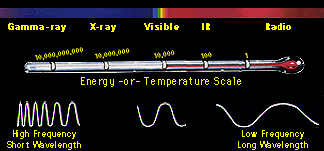
A view of the electromagnetic
spectrum with wavelength and energy values
-
Wavelengths
- The space between 2 high points on a wave

-
Multiwavelength
- different ways that light can be observed.
e. g. X-rays, gamma-rays, optical, infrared,
ultraviolet, and radio
-
Gamma-rays
- Emitted probably from cosmic rays, gamma-rays
have the most energetic form of radiation. When collisions occur between
cosmic ray particles and atomic nuclei, gamma-rays are formed.
-
Cosmic Rays
- Protons and electrons that contain
lots of energy as they travel through space and eventually hit the Earth's
atmosphere
-
galaxy
- a huge group of stars
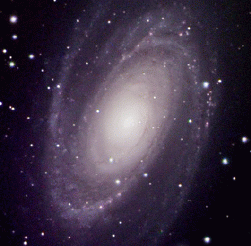
galaxy M81 found in Ursa Major
-
Galaxy cluster
- a group of galaxies that therefore contain many stars
-
Accretion
- in an X-ray binary star system, in which one normal star's
orbit is crossed by a neutron star, when the neutron star by means of
gravitational pull takes matter from the normal star X-rays form. The
process of material transferring from star to star is called accretion.
-
X-ray Transients
- X-ray sources that are bright and then fade in magnitude
-
Magnitude
- a measurement of how bright a star is.
-
Dark Matter
- unknown matter that astronomers think make up the
majority of mass in the universe
-
Pulsar
- a neutron star that rotates quickly. Usually a pulsar has
very strong magnetic poles, forcing the matter to enter or leave through
the poles.

Image of a pulsar with
magnetic field lines around the star, forcing matter to come in or leave
the star through either the north or the south pole. The red line
symbolizes the axis, and the blue arrows show the direction that the
star rotates. In this drawing, the pulsar rotates counter clockwise.
-
Radio Jets
- beams of charged particles that are produced by a black hole
in the center of an AGN
-
Quasars
- The brightest and sometimes farthest objects in our universe.
The energy from quasars comes from lots of matter spilled into and around a
galaxy's black hole. The matter is heated and that causes an enormous amount
of radiation and light.
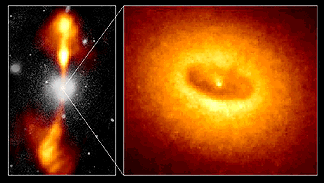
Image of a quasar at the center of
a galaxy
-
Black Holes
- When stars are at the end of their lives, some collapse
onto themselves. Eeventually they collapse to zero volume, pulling
any matter or light within its radius into infinite density.
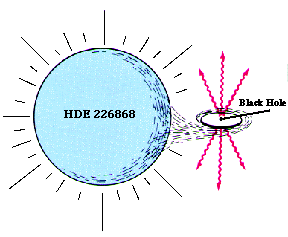
Artists conception of a normal
star (HDE 226868) and a black hole taking matter from the normal star. The
matter swirls around the black hole. When the matter (gas or dust) passes
the point of no return, it sends off X-rays into space (the ziggly red
lines).

Image of a black hole (right) and
a neutron star (left). The matter is circling around the black hole before
it is pulled into infinite density. The center of that picture is black
because black holes are invisible. The neurton star absorbs the matter that
is circling around it, however it is not black in the middle, a star can be
seen.
-
White Dwarf
- A star with low/medium mass that is near the end of its
life
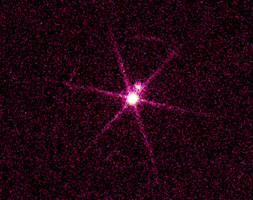
white dwarf Sirius B
-
Supernova
- When a star is at the end of its life it first collapses
onto itself and then it explodes causing the outer atmospheric layer to
be blown away leaving the star to shine brighter then the rest of the
stars in its galaxy.
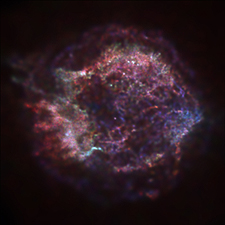
Cassiopeia A supernova
remnant
-
Nebula
- a cloud in the ISM that is filled with bright and/or dark gas
and dust.
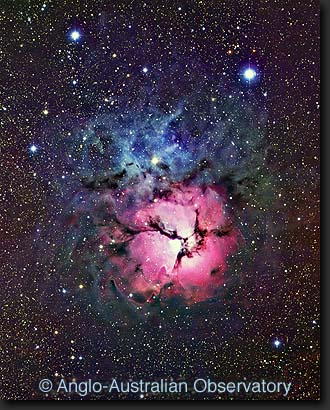
Image of the Trifid nebula
![]()
![]()
![]()
![]()
![]()
![]()
![]()
![]()